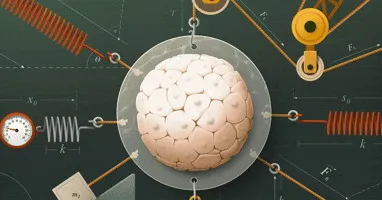The original version of this story appeared in Quanta Magazine.
Sip a glass of wine, and you will notice liquid continuously weeping down the wetted side of the glass. In 1855, James Thomson, brother of Lord Kelvin, explained in the Philosophical Magazine that these wine “tears” or “legs” result from the difference in surface tension between alcohol and water. “This fact affords an explanation of several very curious motions,” Thomson wrote. Little did he realize that the same effect, later named the Marangoni effect, might also shape how embryos develop.
In March, a group of biophysicists in France reported that the Marangoni effect is responsible for the pivotal moment when a homogeneous blob of cells elongates and develops a head-and-tail axis — the first defining features of the organism it will become.
The finding is part of a trend that defies the norm in biology. Typically, biologists try to characterize growth, development, and other biological processes as the result of chemical cues triggered by genetic instructions. But that picture has often seemed incomplete. Researchers now increasingly appreciate the role of mechanical forces in biology: forces that push and pull tissues in response to their material properties, steering growth and development in ways that genes cannot.
Modern imaging and measurement techniques have opened scientists’ eyes to these forces by flooding the field with data that invites mechanical interpretations. “What has changed over the past decades is really the possibility to watch what happens live, and to see the mechanics in terms of cell movement, cell rearrangement, tissue growth,” said Pierre-François Lenne of Aix Marseille University, one of the researchers behind the recent study.
The shift toward mechanical explanations has revived interest in pre-genetic models of biology. For example, in 1917 the Scottish biologist, mathematician, and classics scholar D’Arcy Thompson published On Growth and Form, which highlighted similarities between the shapes found among living organisms and those that emerge in nonliving matter. Thompson wrote the book as an antidote to what he thought was an excessive tendency to explain everything in terms of Darwinian natural selection. His thesis—that physics, too, shapes us—is coming back into vogue.
Time-lapse movie of a gastruloid developing a head-to-tail axis.
Video: Sham Tlili/CNRS
“The hypothesis is that physics and mechanics can help us understand the biology at the tissue scale,” said Alexandre Kabla, a physicist and engineer at the University of Cambridge.
The task now is to understand the interplay of causes, where genes and physics somehow act hand in hand to sculpt organisms.
Grow With the Flow
Mechanical models of embryo and tissue growth are not new, but biologists long lacked ways of testing these ideas. Just seeing embryos is difficult; they are small and diffusive, bouncing light in all directions like frosted glass. But new microscopy and image analysis techniques have opened a clearer window on development.
Lenne and his coworkers applied some of the new techniques to observe the motion of cells inside mouse gastruloids: bundles of stem cells that, as they grow, mimic the early stages of embryo growth.


